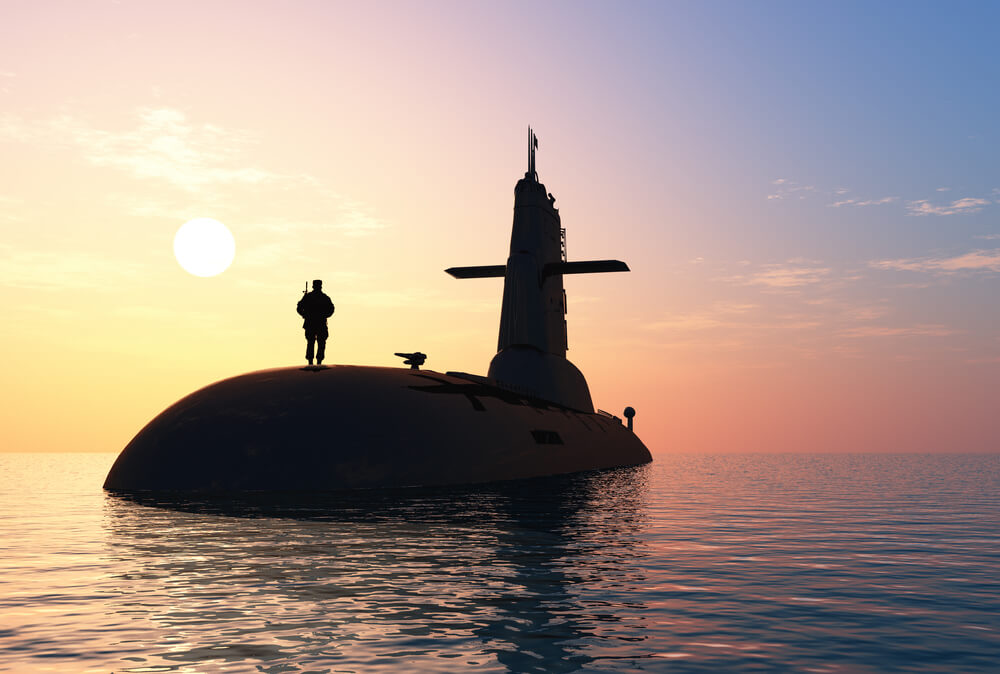How the CIA spent $ 350 million on an operation to kidnap a Soviet submarine

Фото: Depositphotos
At the height of the Cold War, using the eccentric billionaire Howard Hughes as cover, the CIA spent $ 350 million on attempts to steal a Soviet submarine.
Writer Josh Dean talks in detail about one of the most amazing secret operations in American history in his new book, Capture K-129, this book will go on sale 5 September 2017.
The Cold War gained momentum as both sides increased their nuclear potentials, making them all the more deadly.
By the end of the 1960, the Soviet military had already patrolled the Pacific Ocean, having at its disposal a small flotilla of diesel submarines equipped with nuclear weapons.
These submarines could dive, launch attacks and take positions that allowed them to destroy cities on the American west coast in the event of a nuclear war.
The submarine K-129, which had three nuclear missiles on board, left the Russian Kamchatka Peninsula in February 1968. She had to get to a remote part of the Pacific Ocean, located northeast of the Hawaiian Islands.
9 in March, the US Navy reconnaissance ship reported unprecedented activity off the coast of Kamchatka. From there, an entire flotilla of submarines suddenly advanced, which moved deep into the Pacific Ocean, not caring to go unnoticed.
K-129 disappeared - supposedly sank in the middle of the ocean. The proponents of the Cold War in Washington saw this as an opportunity to get at their disposal a mass of valuable intelligence, relating both to nuclear technology and to the decoding of military codes.
At the headquarters of the CIA in Langley, the Azorian project was developed. The purpose of this top-secret mission was to create a huge ship capable of placing a sunken Soviet submarine in its bottom part.
However, the agency needed a cover in order to build this ship and not declassify its tasks. And it could not use a joint stock company as a cover for the 350-millionth deception.
64-year-old Howard Hughes was hiding on the top floor of one of his hotels in Las Vegas. This billionaire, known for its unsociation, was already experiencing a long and strange sunset at that moment.
The eccentric Hughes agreed to become a cover for this plan. When key participants met at a hotel in Los Angeles to work out a black contract, lawyer Hughes left the room several times at critical moments.
One of the government representatives was amazed that Hughes was nearby and in some mysterious way was aware of all the details of the negotiations.
Participants were able to develop such a legend: Hughes company finances the first stage of exploration work to begin mining in the ocean. The next step: to tell about his fake plans about an unsuspecting press.
Although this story was very easy to pass off as another crazy idea of Hughes, this operation required careful study so as not to arouse suspicion from the Soviet Union.
Manfred Kruteyn, an expert in mining in the ocean, was hired specifically to develop a number of convincing arguments justifying the construction of this gigantic ship.
Technical features of the ship Hugshes glomar explorer required a mass of explanations. This ship was supposed to be large enough to lift a million pounds (3,93 tons) weight on 1783 and deliver it unnoticed to the USA.
A few months later, Kruteyn was already listening as a representative of Hughes talks about the birth of a “completely new industry” of deep-sea mining at a luxurious press conference in the Hawaiian Islands.
None of the features of the ship did not cause the slightest doubt. His work was done.
Although this ship could now be built openly, a capture device that needed to be hidden in this world's largest submersible barge needed to be built in an atmosphere of the deepest secrecy.
Secrecy was maintained almost until the launch of the ship.

Фото: Depositphotos
An illegal invasion of Hughes' warehouse in the middle of 1974, should have caused more alarm than he had caused. But when it turned out that the thieves turned out to be just petty crooks, the CIA let this matter go to chance.
July 4 Explore reached destination - 40 degrees of latitude and 180 degrees of longitude. Due to technical problems, several weeks passed before the ship's hull opened and giant ticks called Clementina appeared from it.
Clementine didn’t have time to dive deep enough so that she couldn’t be noticed, as a small rescue tug - such as the Soviet authorities usually used to carry out covert surveillance - began to pursue Explore.
This tug came close, then drifted away, and then returned again, relentlessly following the giant at the very moment when Clementine seized its prey.
4 August the slow process of lifting the sunken submarine began. All crew members felt like the ship is under stress before the beginning of the ordeal.
But suddenly this tension disappeared.
Surveillance cameras recorded the Clementina breakdown and transmitted data to the command post. Being in 9 thousands of feet from the ocean floor, Clementine, who was holding a submarine, crashed. And now a larger fragment of the substrate lay on the seabed again.
In Langley, John Parangoski, the Azorian project developer, passed on this news to his boss, Carl Duckett.
Duckett hit the entire command post, sending an order to sink to the bottom again and capture the object. Then he demanded to open an unprotected radio channel so that he could personally transfer this order to the crew. Explore.
Paragoski had to convince him that this was impossible. First, the remaining part of the submarine at the bottom, most likely, split from a blow into several pieces. It was time to inform Washington that the mission ended in partial failure.
Meanwhile, the Soviet ship continued to follow on the heels of Explore. The stolen part of the submarine was already approaching the surface when the tug came close enough so that the captain of the ship Explore I could make a warning.
This time a violent reaction followed. All members of the crew of a Soviet ship gathered on the deck and, taking off their pants, showed the buttocks to the ship. Explore. Saying goodbye in this way, the tug finally sailed away.
Soon aboard Explore rotting flesh appeared. The bodies of six sailors and almost nothing were found inside the submarine. The Americans managed to extract only one rocket.
In Langley already planned the next mission. But early next year, an article appeared in the Los Angeles Times, stating that the United States was able to lift part of a sunken Soviet submarine from the bottom of the ocean.
Two Los Angeles police officers who were involved in the burglary case told the press that the CIA had warned them about the possible theft of confidential materials. And the newspaper began its investigation.
The CIA was able to convince other major newspapers that in no case could the Soviet Union be warned about the impending operation, since the stakes were too high. This scandal managed to hush up.
Soon after, one ambitious tax official from Los Angeles put out Hughes-owned corporation PRICE astronomical score based on ship cost Explore.
Attempts by several high-ranking officials to petition the taxman failed.
Then the State Commission on Securities and Stock Market launched an investigation into the alleged financial irregularities in the firm. Global marinewhich was engaged in the development of the ship. CIA officials managed to hush up the case.
But all efforts were in vain. In March, the Pulitzer Prize winner Jack Anderson published an article about 350 millions of dollars spent by the CIA in vain.
US Secretary of State Henry Kissinger advised President Ford not to confess anything. From the repeated attempt to raise the Soviet submarine finally refused. In the end, there was no reaction from the Soviet Union.
What happened in the ocean remained there, and the Soviet submarine K-129 still rests at the bottom of the Pacific Ocean.
Original article published on New York Daily News.
Translation prepared edition Inosmi.
Read also on ForumDaily:
What kind of policy regarding Russia is proposed by experts in the American media
How does it feel to be Russian in modern America
“Are you a spy?”: how Russians are treated in Washington
The story of an American, replacing the Soviet employees in the US Embassy in Moscow
Subscribe to ForumDaily on Google NewsDo you want more important and interesting news about life in the USA and immigration to America? — support us donate! Also subscribe to our page Facebook. Select the “Priority in display” option and read us first. Also, don't forget to subscribe to our РєР ° РЅР ° Р »РІ Telegram and Instagram- there is a lot of interesting things there. And join thousands of readers ForumDaily New York — there you will find a lot of interesting and positive information about life in the metropolis.
-
Personal experience: who and why you should not move to the USA5614
-
50 diseases whose presence will increase the cost of health insurance in the USA4329
-
Great opportunities with ChatGPT: 12 easy ways to make money using artificial intelligence1324
-
What should not be on your resume if you want to find a job in the USA763
-
Four unforgivable mistakes immigrants make to the United States552
-
Dependence on cars and one supermarket per city: why ours is unusual in one-story America403
-
Ten secret restaurants in the USA: what is their highlight and how to find them254
-
Personal experience: who and why you should not move to the USA5614
-
Where in the USA to buy the medicines we are used to: a list of pharmacies5330
-
How to hit the jackpot: tips from a man who won the lottery 7 times4898
-
50 diseases whose presence will increase the cost of health insurance in the USA4329
-
Street, avenue, boulevard or drive: how to understand the classification of US streets and roads1461
-
Personal experience: what not to do in America1402
-
Great opportunities with ChatGPT: 12 easy ways to make money using artificial intelligence1324











